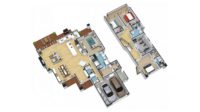Controlling Air Leakage for Improved Building Energy Performance
Testing of air barrier assemblies is an essential intermediate step to demonstrate performance of installed air barriers.










Reducing air leakage in buildings is a cost-effective strategy for improving energy performance. Yet, until recently, energy codes did not have quantitative requirements for air leakage control. Mandatory Air Barrier requirements were recently introduced in the main energy codes such as ASHRAE 90.1, IECC. However, most of these energy codes use an air barrier material compliance option, which does not provide high level of confidence on the performance of an installed air barrier.
In order to improve air barrier practices and increase the effectiveness in air leakage control, Air Barrier Association of America introduced an air barrier evaluation protocol which requires manufacturers to provide third party test reports for air barrier materials and assemblies. This initiative is a huge step in the right direction towards developing minimum performance standards for installed air barriers.
WHAT’S THE BIG DEAL?
Air leakage is the unplanned, unpredictable and unintentional airflow across the building enclosure and occurs when two conditions are present: a driving force and a pathway. The driving force for air leakage is the air pressure difference across the envelope resulting from the combination of wind pressure, stack effect and HVAC design. Air leakage pathways consist of any unintended openings and discontinuities in the building assemblies.
Air leakage can transport heat, moisture and contaminants across the building envelope, therefore it can impact many aspects of building performance. Air leakage control is regulated through energy codes because its impact on energy use can be estimated through whole building energy simulations while other effects are very difficult to quantify. Code compliance with air barrier requirements can be achieved via materials, assemblies or whole buildings as summarized in Table 1, which lists the main air barrier standards and compliance options for North America.
National Building Code of Canada, the first air barrier code in North America introduced in the 1990s, has an air barrier material compliance option. ASHRAE 90.1-2010 is the first U.S. national standard that requires air barriers, and includes two compliance options: air barrier materials or air barrier assemblies. However, the air barrier assembly compliance option is very rarely used in practice. More recently, energy and sustainability standards as well as government agencies introduced whole building testing requirements (these are shown in green shaded rows in Table 1).
Whole building air-tightness testing, which measures the building envelope air-tightness, is the ultimate performance measurement for air barriers effectiveness. However, it might be too costly to test the whole building, and too expensive to correct potential air barrier installation mistakes at the end of the project.
Testing of air barrier assemblies is an essential intermediate step to demonstrate performance of installed air barriers and to develop robust installation guidelines for a continuous air barrier. ABAA, the trade organization representing the center of excellence in the air barrier industry (www.airbarrier.org), has introduced an air barrier evaluation protocol which requires air barrier manufacturers to provide third party test reports to validate the performance of air barrier materials and air barrier assemblies.
ASSEMBLY TESTING PROGRESS
Assembly testing is a big step towards measuring the performance of installed air barriers. Demonstrating the performance of installed air barriers and developing proper details for air barrier continuity and structural integrity begins with understanding the four fundamental requirements for effective air leakage control: air infiltration resistance, continuity, structural integrity and durability. Since air barriers are generally placed on the exterior of the building envelope, the materials’ vapor permeability must also be specified in order to ensure proper envelope design for moisture management.
The test method for assembly testing (ASTM 2357) requires that at least two wall assemblies (8 feet by 8 feet) are tested under specified pressure loads (both under pressurization and depressurization) and they meet the assembly airtightness requirements. The air leakage rates for air barrier assemblies must not exceed 0.04 cfm/ft² at 0.3 inch wc or 1.56 psf pressure differential [0.2 L/(s • m2) at 75Pa], according to current air barrier standards. The ABAA website lists the air barrier assemblies for which third party test reports were submitted and the performance requirements were validated: (www.airbarrier.org/materials/assemblies_e.php)
The air barrier assemblies listed on the ABAA website include:
Self-Adhered Sheet Materials
(4 products)
Fluid Applied Membranes
(23 products)
Sprayed Polyurethane Foam -- Medium Density Closed Cell
(9 products)
Mechanically Attached Flexible Sheets or Building Wraps)
(3 products)
Boardstock Air Barrier –
Rigid Foam Core (2 products)
Testing of air barrier assemblies is an essential intermediate step to demonstrate performance of installed air barriers. ABAA’s initiative to validate the performance of air barrier materials and air barrier assemblies, based on third party testing, is a huge step in the right direction towards developing minimum performance standards for installed air barriers. The ABAA website is a validation of those materials and assemblies that completed the required testing. However, work remains to be done to develop proper testing methodology to simulate real life exposure in order to assess the long term durability of the air barrier continuity. The leading manufacturers are already testing the performance of wall assemblies submitted through thermal cycling under conditions that may be experienced by the building envelope, even though thermal cycling for installed air barriers is currently not required by standards. W&C
Looking for a reprint of this article?
From high-res PDFs to custom plaques, order your copy today!












